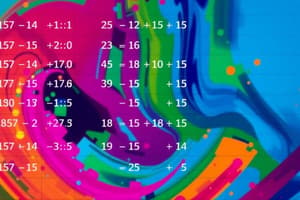Podcast
Questions and Answers
What is the purpose of absolute cell referencing in spreadsheets?
What is the purpose of absolute cell referencing in spreadsheets?
- To make formulas dynamic
- To prevent cells from updating when copied or moved (correct)
- To allow for quick data organization
- To automatically adjust cell references based on their position
What happens to absolute cell references when they are moved within a sheet?
What happens to absolute cell references when they are moved within a sheet?
- They shift horizontally but not vertically
- They remain unchanged (correct)
- They update based on their new position
- They automatically adjust to the new row number
Which symbol is used to make a column absolute in a cell reference?
Which symbol is used to make a column absolute in a cell reference?
- $ (correct)
- @
- &
- #
In an absolute cell reference, what does $C$5 mean?
In an absolute cell reference, what does $C$5 mean?
How does an absolute cell reference differ from a relative cell reference?
How does an absolute cell reference differ from a relative cell reference?
If cell A1 contains the formula =$B$3 + $C$5, what happens when this formula is copied to cell B1?
If cell A1 contains the formula =$B$3 + $C$5, what happens when this formula is copied to cell B1?
What happens when we copy a formula across multiple cells without absolute references?
What happens when we copy a formula across multiple cells without absolute references?
How does placing a dollar sign in front of 'C' affect the reference?
How does placing a dollar sign in front of 'C' affect the reference?
What does '$-$1' denote in cell referencing?
What does '$-$1' denote in cell referencing?
Which mixed reference format locks only the column component of the address?
Which mixed reference format locks only the column component of the address?
What does placing a dollar symbol after just the row number create in a reference?
What does placing a dollar symbol after just the row number create in a reference?
How do mixed reference types benefit users in cell addressing?
How do mixed reference types benefit users in cell addressing?
Flashcards are hidden until you start studying
Study Notes
Cell Referencing in Spreadsheets
Cell referencing is a fundamental concept within spreadsheet applications like Excel, Google Sheets, or LibreOffice Calc—tools we've all come to rely on for organizing data into rows and columns. Understanding how cells can reference other cells allows us to create complex formulas and equations with ease. In this guide, we will dive deeper into absolute cell referencing—a technique used when you want specific parts of your formula to remain constant while others adjust dynamically.
Relative Cell References
Relative cell references are what most people begin using right off the bat. If a cell B2 contains "=A2+B1", and we copy it down one row by selecting B2 and dragging to B3, the resulting cell in B3 would have the formula "=A3+B2". This happens because relative cell references automatically update based on their position from the initial cell. For instance, A2 becomes A3, B1 remains unchanged because B was copied horizontally instead of vertically.
Absolute Cell References
Absolute cell references do not change even if they get moved around within a sheet. They always maintain their exact location, regardless of where you move them to. To make a cell reference absolute, place dollar signs before either the column letter ($) or the row number (#):
For example, suppose cell C8 has the following formula: =$C$-$1 + $D$. When we decide to copy this formula across multiple cells, each new cell will calculate the sum of its own adjacent left cell plus the adjacent upper cell, rather than referencing the original ones. But we might also need some values to remain fixed or pointed towards a particular area; hence comes the usage of the absolute references. By keeping the dollar sign in front of 'C', which represents the column, we ensure that 'C' doesn't change despite shifting the cell. Likewise, '$-$1' keeps pointing to the immediately above cell, irrespective of being dragged upwards or downwards.
Mixed Reference Formats
Mixed reference formats allow partial absolution in both horizontal and vertical directions. For example, placing a dollar sign after only the column letter results in "$ColumnNumber". Similarly, putting a dollar symbol after just the row number gives "#RowNumber". These mixed reference types enable the user to lock certain components of the address while still allowing flexibility in others.
In conclusion, understanding cell referencing techniques such as relative and absolute cell addresses opens a world of possibilities in our everyday spreadsheet workflows. Whether it involves creating charts, building macros, or simply automating repetitive tasks, these basic functionalities empower us to tackle more advanced projects confidently.
Studying That Suits You
Use AI to generate personalized quizzes and flashcards to suit your learning preferences.




